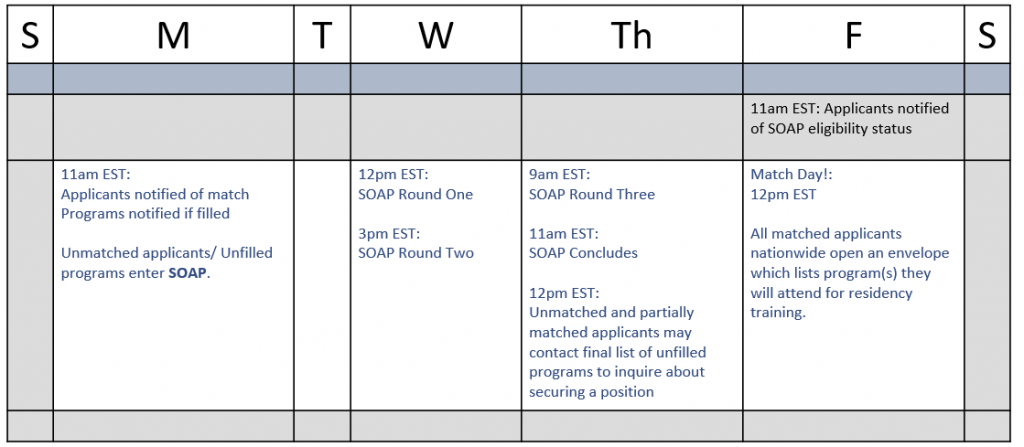Learning to become a medical doctor is a long, grueling, complicated, expensive and difficult process. So is the residency matching process, albeit on a slightly smaller scale.
Months of applications, interviews, travel, and ranking of preferred programs end in Match Week and ultimately Match Day, the third Friday in March. This all-important day is the culmination of hard work, hopes, and dreams. It is also the result of some complex processes and algorithms, all aimed at matching the right doctors-in-training to the right residency programs.
Even to those participating in the Match, it’s difficult to understand. We are well acquainted with it by now, and are here to share our knowledge of how it all works.
How the residency match process works: the one-sentence version
Medical students are matched into residency programs, according to the preferences of both the students and the programs, through a process operated by the Electronic Residency Service (ERAS) and the National Resident Matching Program (NRMP).
How the residency match process works: The longer version
Let’s break it down.
The Residency Application Process
The residency application process starts each year on September 15th. Medical students submit their applications via the Electronic Residency Application Service (ERAS). This includes:
- A completed ERAS Application
- Their personal statement
- Letters of recommendation
- Medical Student Performance Evaluation (MSPE or “Dean’s Letter”)
- Medical School Transcript
- A photograph
- USMLE/COMLEX-USA (licensing exam) transcript
International Medical Graduates (IMGs) who completed medical school outside of the United States must also include:
- Their ECFMG Status Report
- A Postgraduate Training Authorization Letter (PTAL or “California Letter”) if seeking to train in California.
Upon application submission, medical students pay fees to ERAS according to the following schedule.
Programs per specialty:
- Ten or fewer: $99
- 11-20: $14 each
- 21-30 $18 each
- 31 or more: $26 each
It’s a little complicated, so here’s an example of the payment structure:
If a student were to apply to 22 Family Medicine programs and 15 Internal Medicine programs, they would pay $99 for both the first ten FM and first ten IM programs ($198), then $14 each for the next ten FM ($140), $18 each for the final 2 FM 1$36), and $14 each for the next five IM ($70). Their total fee would be $444.
Interview season
Applications are reviewed by residency program directors, faculty, program coordinators and other supporting administrative staff. Competitive applicants are then invited to interview. To organize and schedule interviews en masse, programs use Thalamus or another interview scheduling software—or rely on manual emails, phone calls, and records.
The interview season extends from early October to mid-February. Applicants travel to hospitals nationwide to attend interviews, where they meet with program leadership and faculty, and tour hospital facilities. They are also evaluated by faculty on how well they would fit in that particular residency program.
The next step: build and submit a Rank Order List
Throughout the interview process, applicants begin composing a preliminary Rank Order List (ROL). This is a list of the residency programs in which they wish to—or would be happy to—train, ranked in order of their preference. On the other side of the equation, residency programs create ranked lists of interviewed candidates they desire to have as residents.
In a serious relationship? The Match can take that into account. Applicants matching with a significant other may do so as part of a joint ROL process known as “Couple’s Matching.”
These lists are finalized in mid-February through formal certification with the NRMP. Once finalized, ROLs are entered into the NRMP R3 system, where the algorithm does its all-important job.
The NRMP Match algorithm
The NRMP Match is determined by a mathematical algorithm, which aims to optimize satisfaction for applicants and programs, according to their ranked choices. The research behind this algorithm was the basis for awarding the Nobel Prize in Economic Sciences in 2012.
The algorithm is “applicant-proposing” or “applicant-centric,” meaning that it favors the applicants, who are placed into programs based on the order they have ranked programs. For a match to occur, both applicants and programs must rank each other. Additionally, residency programs must have available positions remaining.
A note to applicants:
The residency match process algorithm was designed to allow you to rank your favorite programs in order of preference. Trying to manipulate your match by ranking higher the programs in which you think you have a better chance of matching is not helpful. The algorithm allows you to rank your top picks first without penalty, and there is no disadvantage in taking a shot at the best program possible.
Do not rank programs lower because you think your chances of getting in are lower. That’s not how the Match is designed!
How exactly does the Residency Match Process Algorithm work?
The algorithm starts by attempting to match each applicant to their first-choice program. If there is a match with a residency program, the candidate is “tentatively” matched. This means that the candidate will match at that institution, as long as applicants ranked higher than that candidate at that particular institution do not occupy the available positions.
If an applicant’s first choice is already occupied by higher-ranked candidates or a “tentatively” matched candidate is subsequently displaced, the algorithm will attempt to match the displaced candidate to their second choice. And then to their third choice. And so on.
Once a candidate has matched into their most preferred available choice, with no higher ranked candidates securing remaining available positions, a “tentative” match becomes a “confirmed” match. This is the program where the candidate will complete their residency training.
Once rank choices for all candidates have been run through the algorithm, the match is considered final. This leads to Match Week, the last stage of the residency match process.
Match Week and SOAP: The final hurdle
“Match Week” is the third week of March, a very important time for medical students. It ends with “Match Day,” the third Friday of March. Here’s the basic schedule for the week:

On Monday of match week at 11am EST, applicants are informed of whether they successfully matched into residency positions by email and through the NRMP R3 system—but not where they matched.
For those who matched, it’s celebration time. The NRMP guidelines note that “applicants who learn they are matched are invited to join the joint NRMP, AMA, AAMC Match Week celebration by downloading “I Matched!” images, sharing messages using #Match2019 throughout the week, submitting videos for the YouTube playlist to socialmedia@aamc.org and following the celebration on the joint campaign Tagboard and YouTube playlist pages.”
Applicants who have not matched become eligible for the Supplemental Offer and Acceptance Program (SOAP), which is an additional accelerated supplemental matching process that takes place between Monday 3pm EST and Thursday 11am EST.
There is still opportunity for applicants to match to a program—it just won’t be one that was on their list. Unfilled residency programs are offered to unmatched applicants on their own preference lists, and it works like this:
- Candidates will have one hour after discovering that they are unmatched to research the programs with spaces available. At 12pm EST, ERAS will open and they may submit a maximum of 45 applications to unfilled positions.
- Programs receive the list of SOAP applicants at 3pm EST, and from these interviews build preference lists. Applicants are forbidden to contact programs until the program initiates contact. Programs will spend the Tuesday of match week reaching out to applicants and conducting phone interviews.
- There are three rounds in which programs offer places and applicants decide whether to accept or reject them. Each is two hours long. They take place on Wednesday at 12pm-2pm and 3pm-5pm EST, then on Thursday at 9am-11am EST.
- Applicant offers are extended through the R3 system simultaneously at the end of each round.
- Applicants may accept, reject or allow offers to expire. If accepted to multiple programs, accepting one offer rejects the others. An accepted SOAP offer is binding.
- The majority of positions fill in round one. The unfilled program list updates after each round.
- SOAP ends on Thursday at 11am EST. Unmatched candidates and unfilled programs may then contact each other freely at 12pm EST to fill any remaining positions.
Match Day!
The six-month-long residency match process culminates in Match Day, on the third Friday of March at the end of Match Week. This is a significant milestone in a physician’s career that is celebrated at medical schools nationwide with faculty, mentors, family, and friends.
It is a monumental and emotional day—all applicants open an envelope at 12pm EST to reveal their residency program matches. Every medical school celebrates differently. Some lay out the envelopes on a table leading to a mad dash, while others have candidates open their envelopes on an auditorium stage to read aloud into a microphone. Regardless, it is an exciting day for physicians as they begin the next step in their career!
Should applicants choose not to participate in the Match Day celebrations at their school, they can access their results at 1:00PM EST, when they are sent by email and accessible in the R3 system.
Making matching simpler
Laid out in its entirety, it’s obvious that the residency match process is a lengthy and involved one. The work doesn’t stop there, either—long term, there’s residency to worry about, and in the short term, most new residents must figure out the logistics of moving to a new area and preparing for their new job as a resident.
Thalamus aims to make the whole process a little bit easier for applicants and programs alike. We manage interview scheduling, and just like the NRMP algorithm, we use automation to do it in a way that’s streamlined and cost-effective. Here’s how it works—take a look to see whether Thalamus could be right for you as an applicant or a residency (or fellowship) program!
